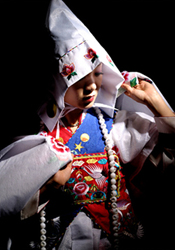
Vocal Music III
Shaman Songs
According to Kirby, theatre originated from shaman ritual séances, and shaman ritual is inherently dramatic.[21]E. T. Kirby, Urdrama: The Origins of the Theatre, 2. New York: New York University, 1975. Sharing common ritualistic elements with the other Tungusic peoples of Manchuria, Mongolia, and Siberia, various forms of indigenous rituals of healing evolved in ancient Korea "synthesizing magic and art, ritual and entertainment, and involving spirits and humans alike. Grounded in the belief that spiritual forces may be invoked and exerted, Korean mudang ritual developed as a kind of spiritual narrative drama,"[22]Chan E. Park, Voices from the Straw Mat, 40. a powerful and timeless inspiration for many folk performances as well as postmodern artistic experiments today.
Chindo Sikkim-kut
Korean shamans, mostly female, are of two general denominations: north of the Han River, mudangs are mostly by possession, and in the south, they are mostly groomed and ordained by heredity, and their performance skills are "formulated and transmitted from generation to generation."[23]Ibid Introduced here is the Chindo Sikkim-kut, "ritual of cleansing" from Chindo island, designated Intangible Cultural Property No. 72, a ritual of purging and guiding the soul of the dead to the other world. The instruments used are:ching, puk, ch'anggo,p'iri (bamboo flute), ajaeng, and sometimes taegûm and haegûm if available.





Trot (Teuroteu) is the oldest type of Korean pop music originating during Japanese rule in the first half of the 20th century.





